Read and download free pdf of CBSE Class 10 Biology How Do Organisms Reproduce Worksheet Set G. Students and teachers of Class 10 Science can get free printable Worksheets for Class 10 Science Chapter 7 How do Organisms Reproduce in PDF format prepared as per the latest syllabus and examination pattern in your schools. Class 10 students should practice questions and answers given here for Science in Class 10 which will help them to improve your knowledge of all important chapters and its topics. Students should also download free pdf of Class 10 Science Worksheets prepared by teachers as per the latest Science books and syllabus issued this academic year and solve important problems with solutions on daily basis to get more score in school exams and tests
Worksheet for Class 10 Science Chapter 7 How do Organisms Reproduce
Class 10 Science students should download to the following Chapter 7 How do Organisms Reproduce Class 10 worksheet in PDF. This test paper with questions and answers for Class 10 will be very useful for exams and help you to score good marks
Class 10 Science Worksheet for Chapter 7 How do Organisms Reproduce
VERY SHORT ANSWER TYPE QUESTIONS
Question: Why is DNA copying an essential part of the process of reproduction ?
Answer: DNA (Deoxyribonucleic acid) copying is an essential part of reproduction as it passes genetic information from parents to offspring. It determines the body design of an individual. The reproducing cells produce a copy of their DNA through some chemical reactions and result in two copies of DNA. The copying of DNA always takes place along with the creation of additional cellular structure. This process is then followed by division of a cell to form two cells.
Question: Give the respective scientific term used for studying.
(i) The mechanism by which variation are created and inherited and
(ii) The development of new type of organism from the existing ones.
Answer: (i) Heredity, (ii) Evolution.
Question: Name two simple organisms which have ability of regeneration.
Answer:Planaria and Hydra
Question: Explain how do organisms create an exact copy of themselves.
Answer:The cell uses biochemical reactions to make exact copies of DNA or genetic material.
Question: Name the information source of making proteins in the cell. State two basic events in reproduction.
Answer:DNA in the nucleus of a cell is the source of information for making proteins. The two basic events in reproduction are:
(i) creation of copy of DNA
(ii) creation of an additional cellular apparatus by cell then the DNA copies separate, each with its own cellular apparatus.
Question: What are the changes seen in girls at the time of puberty?
Answer: At the time of puberty, breast size begins to increase, with darkening of the skin of the nipples. Also, girls begin to menstruate at around this time.
Question: The mode of reproduction depends on which feature of the organism?
Answer:The mode of reproduction depends upon the body design of organism. Those with simple body design may reproduce asexually. Those with complex body design may form gametes and may undergo sexual reproduction.
Question: How does Planaria reproduce? Is this method sexual or asexual?
Answer: Planaria reproduces by a process known as regeneration. It is a type of asexual reproduction in which if Planaria can be cut into any number of pieces, each piece grows into a new individual organism.
Question: What is the advantage of reproduction through spores?
OR
How will organism be benefitted if it reproduces through spores?
Answer:Spore with a cell wall can survive even in adverse conditions. Large number of spores are produced in one sporangium. It is easily dispersed through wind as they are large in number and light in weight.
Question: Where is DNA found in the cell?
Answer:DNA is found in the nucleus.
Question: How do we know that two different individuals belong to the same species?
Answer: Members of same species are capable of interbreeding the same species by the similarity in their body design and other physical features.
Question: What is the importance of DNA copying in reproduction?
Answer: DNA copying is an important phenomenon of reproduction through which the organisms pass on their characteristics to their offspring. It maintains the characteristics in different generations of the species. It also produces variations which are useful for the survival of species for long time
Question: Give the full form of DNA.
Answer: Deoxyribo Nucleic Acid.
Question: How does reproduction help in providing stability to populations of species?
Answer: Living organisms reproduce for the continuation of a particular species. It helps in providing stability to the population of species by producing a new individual that resembles the parents. This is the reason why cats give birth to only cats or dogs give birth to only dogs. Therefore, reproduction provides stability to populations of dogs or cats or any other species.
Question: Why is vegetative propagation practised for growing some types of plants?
Answer: The process by which some plants can reproduce asexually by their vegetative parts like roots, stems and leaves is called vegetative propagation. It has many advantages.
Plants raised by this method can bear flowers and fruits earlier than those produced from seeds. Plants that have lost capability to produce seeds like banana, orange, rose and jasmine can be propagated. All plants produced are genetically similar to the parent plant.
SHORT ANSWER TYPE QUESTIONS
Question: State the changes that take place in the uterus when:
(a) Implantation of embryo has occurred.
(b) Female gamete/egg is not fertilised.
Answer:
(a) When the implantation has occurred in uterus of the mother, the inner lining of the uterus thickens and is richly supplied with the blood vessels to provide nourishment to the growing embryo.
(b) If the egg is not fertilised, it lives for about one day. Since, the thickened uterus lining is no more required, it will slowly break down and come out through the vagina as blood and mucus known as menstruation which lasts for about two to eight days.
Question: What are the advantages of sexual reproduction over asexual reproduction ?
Answer: Advantages of sexual reproduction:
1. In sexual reproduction, more variations are produced. Thus, it ensures survival of species in a population.
2. The new formed individual has characteristics of both the parents.
3. Variations are more viable in sexual mode than in asexual one. This is because in asexual reproduction, DNA has to function inside the inherited cellular apparatus.
Question: How does binary fission differ from multiple fission ?
Answer: In binary fission, a single cell divides into two equal halves. Amoeba and Bacteria divide by binary fission.

Binary fission in Amoeba: In multiple fission, a single cell divides into many daughter cells simultaneously. Amoeba and Plasmodium divide by multiple fission.
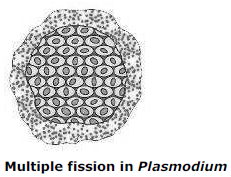
Question: State the changes that occur in human males and females at puberty.
Answer: Puberty is the state of sexual maturiy in humAnswer: The changes that take place in males during puberty are growth of hair on the body, appearance of beard and moustache and the voice becomes hoarse. Females show development of breasts, and beginning of menstruation.
Question: Mention the information source of making proteins in the cell. What is the basic event in reproduction?
Answer: Cellular DNA is the information source of making proteins in the cell.
The basic event in reproduction is copying of DNA so that the cells can further divide.
Question: Why is variation beneficial to the species but not necessarily for the individual?
Answer: Variations are beneficial to the species than individual because sometimes for a species, the environmental conditions change so drastically that their survival becomes difficult. For example, if the temperature of water increases suddenly, then most of the bacteria living in that water would die. Only few variants that are resistant to heat would be able to survive. However, if these variants were not there, then the entire species of bacteria would have been destroyed. Thus, these variants help in the survival of the species. However, all variations are not necessarily beneficial for the individual organisms.
Question: Name one sexually transmitted disease each caused due to bacterial infection and viral infection. How can these be prevented?
Answer: Bacterial infection: gonorrhoea
Viral infection: warts and HIV-AIDS
Prevention: Use of condoms by male.
Question: What is self and cross pollination?
Answer: Self Pollination: It is the transfer of pollen grains from the anther of a flower to the stigma of the same or another flower on the same plant.
Cross Pollination: It is the transfer of the pollen grains from the anther of a flower to the stigma of another flower on a different plant of the same species.
Question: How are the modes for reproduction different in unicellular and multicellular organisms?
Answer: In unicellular organisms, reproduction occurs by the division of the entire cell. The modes of reproduction in unicellular organisms can be fission, budding, etc. whereas in multicellular organisms, specialised reproductive organs are present. Therefore, they can reproduce by complex reproductive methods such as vegetative propagation, spore formation, etc. In more complex multicellular organisms such as human beings and plants, the mode of reproduction is sexual reproduction.
Question: (a) In human body what is the role of
(i) Seminal vesicles (iii) Prostrate glands.
(b) List two functions performed by testes in human beings.
Answer: (a) Seminal vesicles: Produce a fluid which makes the transport of sperms easy.
Prostate glands: Produces a fluid which keeps sperms floating in it and provides nourishment.
(b) Two functions of testes:
(i) They secrete hormone: testosterone responsible for the male characteristics.
(ii) It helps in the formation of sperms.
Question: (a) Draw a diagram illustrating, fertilisation in a flowering plant and label it. Pollen grain, male germ cell, female germ cell, stigma.
(b) Describe the process of fertilisation in plants.
Answer: (a)
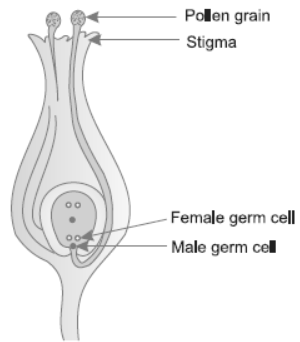
(b) Fertilisation in plants: It takes place after the pollination is done.
(i) The pollen grain develops a tube called pollen tube which carries male germ cells to the ovary.
(ii) The male germ cell fuses with the female germ cell in the ovary and forms zygote.
(iii) The zygote further forms embryo.
(iv) The embryo develops a protective coating and forms seed.
(v) The ovary forms a fruit with seed in it.
Question: (a) Draw a diagram showing longitudinal section of a flower and label on it: stigma, ovary, anther, filament.
(b) How is the process of pollination different from fertilisation?
Answer: (a)
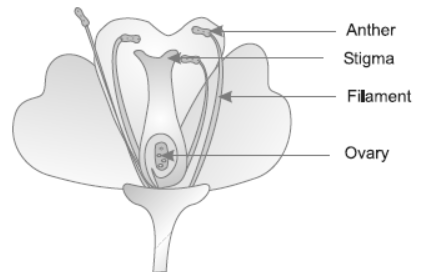
Question: (a) Name the parts labelled A, B, C, D, and E
(b) Where do the following functions occurs? (Img 102)
(i) Production of an egg
(ii) Fertilisation
(iii) Implantation of zygote
(c) What happens to the lining of uterus
(i) before release of fertilised egg.
(ii) if no fertilisation occurs.
Answer: (a) A ⎯→ Fallopion tube
B ⎯→ Ovary
C ⎯→ Uterus
D ⎯→ Cervix
E ⎯→ Vagina
(b) (i) Production of an egg — ovary
(ii) Fertilisation — fallopian tubes
(iii) Implantation of zygote — lining of the uterus
(c) (i) Before release of fertilized egg – the uterus wall becomes thick.
(ii) If no fertilisation occurs – the lining of uterus slowly breaks down and comes out in the form of bleeding.
Question: (a) Explain the terms:
(i) Implantation (ii) Placenta
(b) What is the average duration of human pregnancy? (CBSE 2009)
Answer: (a) (i) Implantation: The zygote when fixes itself on the inner thick wall of uterus for further development is called implantation.
(ii) Placenta: It is the special tissue in the form of a disc which is embedded in the uterus wall. It provides large surface area for glucose and oxygen to pass from mother to the embryo. The waste generated by the embryo also passes into the mother’s blood through this placenta (b) It takes nine months for the human pregnancy.
Question: What are sexually transmitted diseases? Name four such diseases. Which one of them damages the immune system of human body to complete?
Answer: The diseases that spread due to sexual contact from infected person to a healthy person are called sexually transmitted diseases.
Four STDs:
(i) Gonorrhoea (ii) Syphilis (iii) Warts (iv) AIDS
AIDS: Acquired Immuno Deficiency Syndrome damages the immune system.
Question: How does the embryo get nourishment inside the mother’s body?
Answer: The embryo develops inside the mother’s body for about nine months. Inside the uterus, the outer tissue surrounding the embryo develops finger1like projections called villi.
These villi are surrounded by uterine tissue and maternal blood. They provide a large surface area for exchange of oxygen and nutrients. Also, there is a special tissue called placenta, which is embedded in the uterine wall. The embryo receives the oxygen and nutrients from the mother’s blood via the placenta. The waste materials produced by the embryo are also removed through the placenta.
Question: List two advantages of growing grapes or banana plants through vegetative propagation.
Answer:(i) Characteristics of parent plants are preserved.
(ii) Since these plants do not have viable seeds, therefore vegetative propagation is advantageous.
Question: What are changes seen in girls at the time of puberty?
Answer:(i) Change in voice.
(ii) Increase in size of breasts.
(iii) Appearance of hair in armpit and genital hair (pubic hair).
(iv) Widening of hips.
(v) Rapid physical growth.
(vi) Onset of menstruation.
Question: Name the type of asexual reproduction in which two individuals are formed from a single parent and the parental identity is lost. Write the first step from where such a type of reproduction begins. Draw first two stages of this reproduction.
Answer: Binary fission, e.g. Fission in Amoeba Elongation of cell and its nucleus is the first step.

Question: Explain the term ‘Regeneration’ as used in relation to reproduction of organisms. Describe briefly how regeneration is carried out in multicellular organisms like Hydra.
Answer:Regeneration is the ability to produce an organism from their body parts. Many fully differentiated organisms show ability to reproduce by regeneration. In hydra, if the body is cut into two or three pieces, the lower part will develop head while the upper part will develop rest of the body. If its cells are separated, hydra will reform its structure by regeneration.
Question: Why does menstruation occur?
Answer: Menstruation occurs in females when the egg produced inside the cervix is not fertilized. Since the egg does not fuse with the male gamete, so the thick and soft lining of uterus having a lot of blood capillaries in it are not required. This unfertilized egg dies within a day and the lining breaks down shedding blood along with other tissues. This comes out of the vagina in the form of bleeding.
LONG ANSWER TYPE QUESTIONS
Question: Draw a labelled diagram of the longitudinal section of a flower .
Answer:
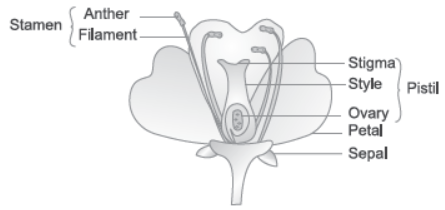
Question: (a) List three different categories of contraception methods.
(b) Why has Government of India prohibited prenatal sex determination by law? State its benefits in the long run.
(c) Unsafe sexual act can lead to various infections. Name two bacterial and two viral infections caused due to unsafe sex.
Answer:
(a) (i) Barrier method, (ii) Oral pills, (iii) Use of copper-T, (iv) Vasectomy in males, tubectomy in females.
(b) - It is because female foeticide is increasing.
- It leads to unbalanced sex ratio i.e., more males, less females.
On long run, it will help in maintaining healthier (equal) sex ratio.
It will save mothers from illegal medical termination of pregnancy and health issues.
(c) Gonorrhoea and syphilis are bacterial infections.
Warts and HIV-AIDS are viral infections.
Question: (i) Describe the various steps involved in the process of binary fission with the help of a diagram.
(ii) Why do multicellular organisms use complex way of reproduction?
Answer:
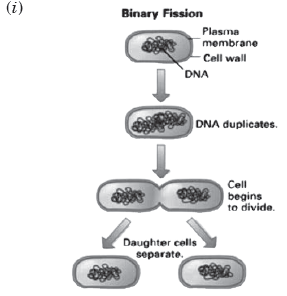
(ii) Multicellular organisms cannot reproduce by cell because they are not simple random collection of cells.
They have specialised cells, organised as tissues which are organised into organs.
Cell-by-cell division would be impractical (not practical).
Multicellular organisms require to use more complex ways of reproduction.
Question: List four points of significance of reproductive health in society. Name any two areas related to reproductive health which have improved over the past 50 years.
Answer: Significance of reproductive health in society are:
(i) Prevent STD (Sexually Transmitted Disease)
(ii) Advantages of small family
(iii) Less mortality among new borns
(iv) Reduces cases of maternal mortality
Two areas of Improvement are:
(i) Family planning. (ii) Decrease in STD cases.
Question: (i) Draw a sectional view of human female reproductive system and label the part where (a) Egg develops, (b) fertilisation takes place, (c) fertilised egg gets implanted.
(ii) Describe in brief the changes that uterus undergoes (a) to receive the zygote (b) if zygote is not formed.
Answer:
(i) (a) Egg develops in ovary.
(b) Fertilisation takes place in fallopian tube.
(c) The fertilised egg gets implanted in uterus.
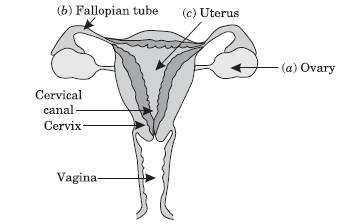
(ii) (a) The inner uterus lining becomes thick to receive the zygote and is supplied with blood and nutrients to nourish the embryo.
(b) The inner uterus lining breaks and released in the form of blood and mucus through vagina.
Question: Explain what happens when:
(a) Testosterone is released in males. (b) Pollen grains falls on the stigma of flowers.
(c) Egg fuses with sperm cell. (d) Planaria is cut into many pieces.
(e) Buds are formed on notches of the bryophyllum leaf.
Answer:
(a) (i) Formation of sperms and change in appearance.
(ii) Thick hair growth on face stet and pubic region and change in voice.
(b) A tube grows out of the pollen grain and travels through the style to the ovary.
(c) Zygote is formed i.e. fertilisation takes place.
(d) Each piece grows into new organism.
(e) Buds may fall on the soil and change into new organism.
Question: Identify the following methods and give one example of each:
(a) Process in which reproduction takes place by breaking up of parent into several fragments.
(b) Process of dividing of organisms into many cells simultaneously.
(c) Process of reproduction by formation of bud on the parent body.
(d) Process of reproduction by formation of spores.
(e) Process used by multi-cellular organisms to reproduce by cutting into many pieces and each piece forms a new individual.
Answer: (a) Fragmentation, Spirogyra (b) Multiple fission, Plasmodium
(c) Budding, Yeast/Hydra (d) Spore formation, Rhizopus
(e) Regeneration, Planaria
Question: Illustrate the following with the help of a suitable diagrams:
(i) Regeneration in Planaria
(ii) Budding in Hydra
Answer: (i) Regeneration in Planaria
Planaria: If it is divided into 3 parts a, b and c, each part grows as a new individual (IMG 105)
| CBSE Class 10 Science Acids Bases And Salts Worksheet Set A |
| CBSE Class 10 Science Acids Bases And Salts Worksheet Set B |
Worksheet for CBSE Science Class 10 Chapter 7 How do Organisms Reproduce
We hope students liked the above worksheet for Chapter 7 How do Organisms Reproduce designed as per the latest syllabus for Class 10 Science released by CBSE. Students of Class 10 should download in Pdf format and practice the questions and solutions given in the above worksheet for Class 10 Science on a daily basis. All the latest worksheets with answers have been developed for Science by referring to the most important and regularly asked topics that the students should learn and practice to get better scores in their class tests and examinations. Expert teachers of studiestoday have referred to the NCERT book for Class 10 Science to develop the Science Class 10 worksheet. After solving the questions given in the worksheet which have been developed as per the latest course books also refer to the NCERT solutions for Class 10 Science designed by our teachers. We have also provided a lot of MCQ questions for Class 10 Science in the worksheet so that you can solve questions relating to all topics given in each chapter.
You can download the CBSE Printable worksheets for Class 10 Science Chapter 7 How do Organisms Reproduce for latest session from StudiesToday.com
There is no charge for the Printable worksheets for Class 10 CBSE Science Chapter 7 How do Organisms Reproduce you can download everything free
Yes, studiestoday.com provides all latest NCERT Chapter 7 How do Organisms Reproduce Class 10 Science test sheets with answers based on the latest books for the current academic session
CBSE Class 10 Science Chapter 7 How do Organisms Reproduce worksheets cover all topics as per the latest syllabus for current academic year.
Regular practice with Class 10 Science worksheets can help you understand all concepts better, you can identify weak areas, and improve your speed and accuracy.

